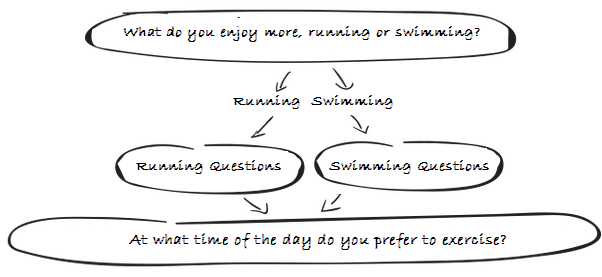
To have respondents stay with your survey from start to end, it’s important to keep surveys interesting and as short as possible. For this reason we may want to leave out questions when they’re not relevant for some respondents. It can also be important to ask questions one way for some respondents and differently for others. We want to personalize our survey as much as possible. We are able to do this using branching logic.
What is branching logic in surveys?
When preparing questions for your survey you may want to display some questions only for particular respondents while skipping them (or having them appear differently) for others. This is where branching logic comes in; displaying or not displaying certain questions depending upon answers of previous questions.
As an example, consider a survey which purpose is to find what customers think of certain store products. The survey first asks respondents for their age group and their sex. It may then ask teenage, female respondents to offer their opinion of the short skirts products line. However, as they generally do not purchase expensive jewelry, the survey would not ask the teenage girls about the expensive jewelry products. Older women are less likely to care much about mini skirts. For them, the survey might show questions regarding the jewelry line but skip questions regarding mini skirts.
Similarly, some surveys are intended only for a particular audience. We would like respondents who we find out are not of that audience to altogether discontinue answering the survey or, at least, skip some questions. For example, a survey might try to find out students’ experiences during a recent camping trip. While the survey is sent out to all the students, some may have not participated in the trip at all. For these students the survey may not be relevant. It makes sense to first ask the students whether they’ve gone on the camping trip. Students answering “No, I did not go on the trip” may skip to the end or, alternatively, to a question asking for the reason they missed the trip.
How it works
The purpose of “branching logic”, or “display rules”, as we like to call them, are to display or skip questions according to respondents’ answers of previous questions. For each question there is the option to display or not display the question according to previous answers. Similarly, each question, depending upon its answer, has the option of skipping to another destined question further along the survey.
Adding branching logic is easy; watch the video
The following video shows how to apply branching logic in your surveys. In the video we create a simple survey asking hotel customers how they felt about their stay. We include the question “We’re sorry you did not enjoy your stay… Please let us know how we can improve”. We then set up a display rule to display this question only for respondents rating their stay with a low score. In this video our survey is set up until minute 4. If you are already familiar with setting up a basic survey, you can skip to minute 4 of the video.
Click here for more info on how to add display rules to your survey.